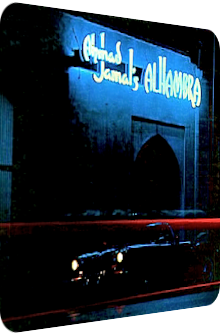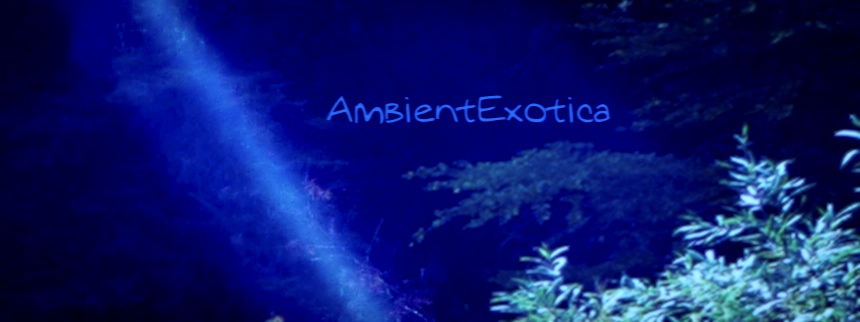
Ahmad Jamal
Alhambra
1961
Alhambra is a live recording by pianist Ahmad Jamal (born as Frederick Russell Jones in 1930) and his trio, comprising of ten renditions recorded in June 1961 and released in the same year on the Argo label. Despite the magical title, the performance does not take place in the famous Spanish Alhambra palace that is situated in Granada, but Ahmad Jamal’s own Jazz club in Chicago which he ran for a short time. In this regard, the album is one of the rather common live recordings of Jazz trios, but has its very strong moments and links to the Exotica genre. The trio features Jamal on the piano, Israel Crosby on the bass and Vernell Fournier as the drummer. This setup already shows where these arrangements are heading to. This is your bog-standard Jazz trio. No exotic percussion, not even a mallet instrument make it to the album.
Notwithstanding these missing traces of exoticism, the album lures with other characteristic qualities: firstly, the feeling of a tropical night is all over the recording, even in those compositions whose titles do suggest otherwise. Jamal’s work on the piano and the many quiescent phases as well as the cautiously fragile schemes expand the yearning and carefreeness. Secondly, this is thankfully no convoluted work of labyrinthine proportions. All arrangements are comparably accessible and multilayered at the same time. The hissing hi-hats and vesiculating double bass specks are ever-present, the ensuing cavities of spaces and sounds feel like mesmerizing grottos. Said two qualities make the album compatible to the specific needs of Exotica listeners even without the respective instruments. And who knows, maybe there are clear cut Exotica gold standards on board too…
We Kiss In A Shadow by Oscar Hammerstein II and Richard Rodgers opens the performance at the Alhambra. Naturally, it cannot be as grandiloquently Asianized as Martin Denny‘s rendition (found on 1959's Hypnotique), but the trio does not even want to achieve this anyway. And yet the five minutes gleam in an ashen complexion of tints due to the nocturnal insouciance that unfolds throughout its runtime. Vernell Fournier boosts the midtempo with the ever-present oomph of his drums and glacial cymbals. Israel Crosby’s moist double blass blebs are ameliorating the bandleader's jumpy but highly accessible performance on the piano. I particularly like the interdependencies between the dreamy chord-heavy segues and the plinking moonlit driblets in front of the heavy drums. Not Exotica per se, but undoubtedly exotic due to its timbre.
Charles N. Daniels’, Gus Arnheim‘s and Harry Tobias’ Sweet And Lovely decreases the magic that was present in the opener. A city-strolling beat scheme schleps itself forward and comprises of the expected amorous connotations by means of luckily dualistic, namely romantic-energetic piano alcoves. The presence of Fournier’s sizzling cymbals revs up the brazen verdure of this downtempo number further.
Cheekily calculated, an interpretation of The Party’s Over by Adolph Green, Betty Comden and Jule Styne is next, and it is a delight due to its lively but well-groomed rhythm structure, the staccato euphony of the piano chords and the great interplay between Jamal and Fournier. This version is one hundred times better than the big band-fueled takes out there! This one has “spring” written all over its physiognomy. Quieter undertones and sudden eruptions of glee create a Cocktail Lounge tune par excellence. One of the very best renditions to ever grace the Alhambra Jazz club. The following take on Cole Porter’s Love For Sale then captures the lovestoned-desperate dichotomy of the original notation very well, but transfers it yet again into a somewhat magical and enchanting glitzscape of glistening glissando cascades, double bass spirals and the amplification of its lacunar structure by means of the interstitial afterglow between the cymbals, hi-hats and piano chords. The middle section strays away from the original but nevertheless ennobles the performance with a shimmering moon-like allure.
Claude Thornhill’s Snow Fall is another revelation, especially so since there are very few Exotica songs out there dedicated to freezing temperatures. This Ambient-oid take is an utter delight, whisper-quiet and supercharged with multitudinous crystalline chords and ice flower-resembling tone sequences, all of them euphonious, mystical and transcendental. A wondrous and all too short inclusion, but a stellar one at that!
Henri Woode’s and Theodore McRae’s Broadway kicks off side B and replaces the child-like gaze of Snow Fall with proper glamour. For almost a whopping eight minutes, this polymorphous composition is admittedly poeticizing and powdered with stardust-like piano serpentines, but enthralls via its uplifting midtempo alone. The dynamics change very often in this polymorphous piece, grandiloquence and metropolitan neon lights are transformed into music by the fluxion of sustain and silence. While Ann Ronell’s Willow Weep For Me is the slowest and almost beatless artifact of lachrymosity of the trio’s live performance – loaded with genteel piano helixes and a fizzling cavalcade of soothing hi-hats –, Jacques Prévert’s and Joseph Kosma’s classic Autumn Leaves surprises with its fast-paced rhythm that is only replaced by even faster rhythms that kill the threnodic melancholia almost instantly and exchange it for good with effervescent summer-like (!) sunbursts and pointillistic rain allusions. Even pentatonic sequences are featured.
Isn’t It Romantic by Lorenz Hart and Richard Rodgers turns out to be a progressive take which launches in a mellow fashion and with golden-shimmering chords of the higher pitch range, but soon changes into a state where the tones become jumpier and the cymbals louder. The magic is amiss, and if it is there, I am not capable of grasping it. The rare letdown of this performance, a performance which is finished with an Exotica tune par excellence, Ernesto Lecuona’s Andalucía aka The Breeze And I. Ahmad Jamal’s trio plays a particularly bubbling version with silkened staccato cymbals and sun-reflecting piano crystals. Another all too short apotheosis, but a gorgeous and necessary one that connects the album to the very genre that is otherwise few and far between.
While not particularly exotic per se, I am still rooting for a place of Ahamd Jamal’s Alhambra somewhere in the outer rims of Exotica. No birdcalls, not even a single conga made it to the posh arrangements, and The Breeze And I is the only classic genre-related track on here, so things look admittedly grim in this regard. However, there is one area where this Jazz album really shines, and this comes as a surprise given the fact that this is a live recording: it is enormously soothing and at least as accessible despite its eclectic channels! The takes on the nature-depicting Snow Fall and Autumn Leaves offer a magnitude of dreamy tone sequences and several delicate arabesques, whereas The Party’s Over and Broadway – above all – are transmutational arrangements which comprise of vivacious intersections of both the involuted and streamlined kinds.
The nightly aura is well embedded in the music, the audience is up for an enchanting evening, and the band members have played for years and know their signature instruments well. Alhambra is much more similar to the rather serious and devoted piano-centric arrangements of Rene Paulo, Stanley Black and Irving Fields than to the flamboyancy of the oft-mentioned Exotica luminaries, but this is not a problem at all, especially not when the album is so embracing and open. Fans of nightly Jazz-driven Lounge music with an exotic aura rather than exotic instruments will certainly enjoy the teamwork of the trio.
Exotica Review 279: Ahmad Jamal – Alhambra (1961). Originally published on Nov. 9, 2013 at AmbientExotica.com.
